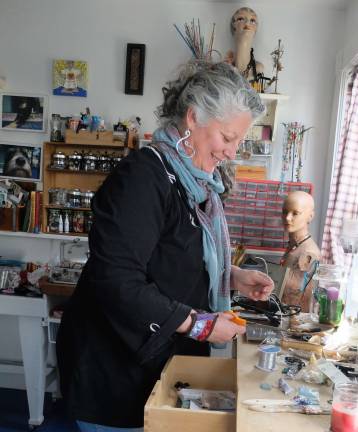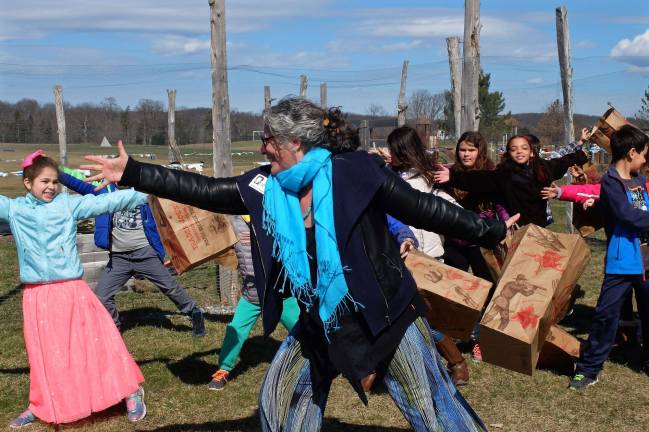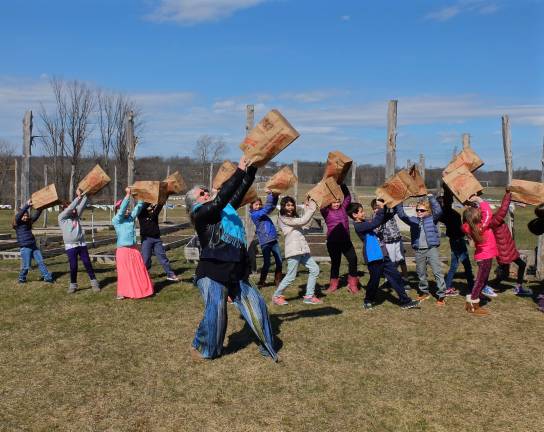Dancing at school can make learning ‘easy-peasy’



Linda Mensch moves gracefully through the classroom, wearing several unique jewelry pieces of her own design and a beatific smile. She is in her element, surrounded by children.
Mensch describes dance as “my best friend since I was seven.” A serious injury almost derailed her dance career as she was about to enter college, but instead broadened her focus to include the study of choreography. She found her niche in the modern dance movement. After dancing, teaching, and owning her own dance company in New York City for many years, she relocated to Warwick and opened a modern dance school. The Moving Company recently celebrated its 20th anniversary.
Eager to integrate movement into the curriculum, teachers Nancy Nachtigal and Maripat Barlow-Layne received a grant from the Warwick Foundation for Excellence in Learning for their Garden Inspired Movement Project. Enter Linda Mensch.
Mensch and her partner Glen Carter were recently named Warwick’s Artists in Residence for the year. For Mensch, creativity is found everywhere, not only in the dance studio. Her Front Porch Arts Program combines found-object art projects, storytelling and dance, and moves freely about the village of Warwick, culminating in an art exhibition at The Conscious Fork. She also makes a film each year for the Warwick Summer Arts Festival, teaches movement to at-risk youth, and creates one-of-a-kind jewelry and art installations. No matter what she does, Mensch’s magic is in drawing out creativity in all of those she works with, regardless of age or ability.
On the day I visit Sanfordville Elementary, Mensch is encouraging kids to choreograph their own dance based on the life cycle of plants. She passes out paper grocery bags to the children, who range from kindergartners through fifth graders. The bags are props to introduce the kids to the idea of improvising their own movements. She gives them basic instructions, starts the music up, and stands back to let each child bring his or her own interpretation to the moves.
As the children twirl and leap and strike poses with their bags, the teachers point out the “deep learning” happening all around them. The kids are in fact building a reportoire of movements related to the science curriculum, internalizing the concepts of patterns and cycles in nature.
The finished dance will be performed in front of the whole school in May. But “process, that’s the most important part,” said Mensch. “To be able to go into the classroom and use everyday moments to create art.”
The joy and sense of achievement the kids feel is obvious in their body language. That “feeling of success” is what Mensch loves most about teaching modern dance. “Everyone can do it –break it down and put it to music and it’s dance.”
Take Lacey, a kindergartner. (Lacey’s not her real name.) “‘Lacey’ started school a dreamy child, completely disinterested in letters, numbers, or her peers,” said Nancy Nachtigal, a kindergarten and first-grade teacher in Sanfordville’s Partners in Education program. “She regularly ‘forgot’ letters she had just recognized on the same page and played alone at recess, clearly in her own world. Once the movement lessons with Ms. Linda started, Lacey immediately identified, ‘I am good at this because I am a dancer.’
“Very soon afterward, she began to say, ‘I am good at counting,’ ‘I rock at my letters now!’ and ‘This is easy-peasy,’” said Nachtigal.
“We can attribute this unfolding to other influences” –- like her developmental stage, said Nachtigal -- “but Lacey believes it’s because she is a dancer.”